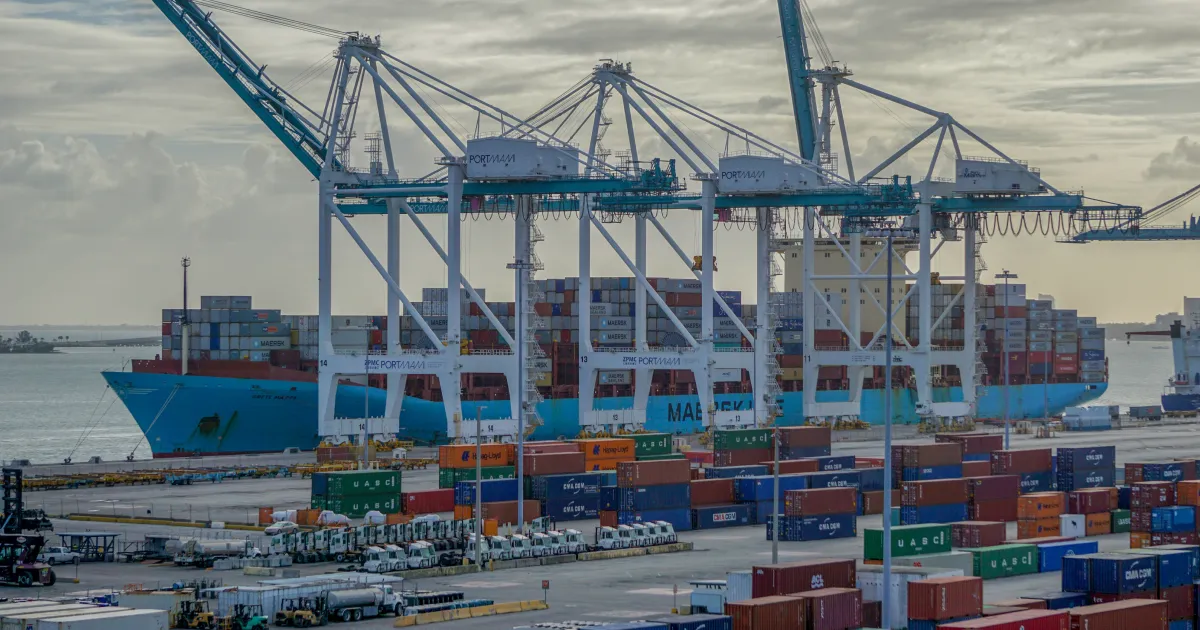Discover the tools procurement pros and resiliency program managers use to take on the most complex supply chains.
How many countries does it take to make an iPhone? Apple works with suppliers in 43 countries across six continents to put a phone in your pocket—and those numbers only get bigger when you look at where the raw materials come from. As companies have focused on making supply chains leaner over the years, supply chains have spread out across the globe in an efficient and cost-effective network. In a perfect world, there would be no disruptions to this system, and it would always run smoothly.
Unfortunately, that isn’t the case. Resilinc’s 24/7 AI-power supply chain monitoring system, EventWatchAI, sends out 450 supply chain disruption alerts on average every week. That’s a lot for supply chain resiliency program managers to handle alone, which is why we’ve put together this list of the top tools for mapping complex supply chains that you need in your toolbox.
Traditional Methods of Supply Chain Mapping
In the past, companies had to manually map their supply chain. This meant keeping track of suppliers in spreadsheets and physically updating contact information, locations, and more over time. However, this starts to get complicated quickly, and it becomes easy to lose track of suppliers who are multiple tiers deep in the supply chain—costing companies time and money when a disruption occurs.
Rick Freeman , Resilinc’s Director of Advisory Services, summed up the problem with the traditional mapping well, “Many companies are still in a reactive stage of maturity when it comes to SCRM. When an event happens, they rely on Excel sheets and hundreds of phone calls. Companies will say, ‘We’re really good at it!’ I tell them that’s great, but your competitors have an advantage over you. When an event occurs, they get responses back in minutes when a site is impacted. Those competitors don’t have to utilize ten people or make 400 phone calls to figure out the problem.”
, Resilinc’s Director of Advisory Services, summed up the problem with the traditional mapping well, “Many companies are still in a reactive stage of maturity when it comes to SCRM. When an event happens, they rely on Excel sheets and hundreds of phone calls. Companies will say, ‘We’re really good at it!’ I tell them that’s great, but your competitors have an advantage over you. When an event occurs, they get responses back in minutes when a site is impacted. Those competitors don’t have to utilize ten people or make 400 phone calls to figure out the problem.”
Technology-Driven Supply Chain Mapping
Instead of relying on traditional methods, we recommend technology-powered supply chain solutions to house and manage all your suppliers, locations, and parts in one platform. A supply chain risk management platform can help your company have better visibility and tools to respond faster to disruptions than your competitors. Here’s a look at some technology-drive mapping tools to utilize:
1. Supplier Validation

First, look for a platform that helps you validate your suppliers. A lot of the time, a supplier’s supply chain is not in the public domain—so this is an important step to gain the visibility you need. Resilinc has an extensive database with over 13 years of supplier-validated data that empowers companies with actionable insights to mitigate risks and capitalize on strategic opportunities.
We’ve mapped and validated a majority of suppliers in key industries, which immediately becomes available and useful to our customers. We’ve mapped:
- 75% of the aerospace and defense supply chain
- 65% of the automotive, industrial, and heavy machinery supply
- 75% of the life sciences, pharma, medical device, and health care supply chain
- 95% of the high-tech supply chain
That’s over 800K suppliers, one million sites, four million parts, and 100K commodities validated across 20 industries!
2. Hybrid Mapping: AI and Multi-Tier

A powerful and cost-effective way to uncover your suppliers is by using a hybrid approach to mapping: combining supplier-validated, multi-tier mapping and AI mapping. In our blog Multi-Tier Mapping vs. AI mapping, we explore the pros and cons, but ultimately, the best solution is to use both together for unparalleled accuracy. Resilinc’s Multi-Tier Mapping combines real-time, supplier-validated data with advanced AI algorithms to deliver unmatched mapping accuracy down to the part-site level. These two technologies combine to increase efficiency when mapping your supply chain so that no supplier is left unseen.
Resilinc’s hybrid solution is currently being used by today’s largest global organizations, enabling them to visualize their entire supply chain, down multiple tiers. By having visibility into the structure of their supply chains, into the sub-tier supplier level, these organizations have a lot of information at their fingertips within minutes of a potential disruption. They know precisely which suppliers, sites, parts, and products are at risk, which allows them to put themselves first in line to secure constrained inventory and capacity at alternate sites.
3. Risk Assessments and Compliance

After you map your supply chain and validate your suppliers, it’s important to assess the risk of each of your suppliers. Is there a supplier in a risky, geopolitical location? Are they the only producer of a critical part? Uncover where there are weaknesses in your supply chain by sending out risk assessments to your suppliers. Some supply chain risk management platforms help make sending risk assessments easier.
Resilinc’s RiskShield is a dynamic solution that reveals, quantifies, and centralizes information for superior supplier intelligence. It allows you to decide how risk is scored and calculated for different parameters such as event response, natural disaster, ESG, financial health, operational measures, cyber security, geopolitics, etc. Then, all of this information is kept on a clean, accurate single-source-of-truth platform.
Assessing risk is particularly important for ESG compliance for legislation like the German Due Diligence Act and the Uyghur Forced Labor Prevention Act (UFLPA). Learn more about how Resilinc can help with UFLPA here.
4. Supplier Communication

Look for a mapping platform that makes it easy to onboard new suppliers and communicate directly with your existing suppliers. Storing all your supply chain data in one place, along with messages and files from suppliers, can help save you time when there is a supply chain event. For example, if you have parts stopped at customs and need to provide due diligence, you can easily access any communications with your supplier.
Resilinc’s mapping platform helps facilitate communication and coordination among your supply chain stakeholders and suppliers when disruption strikes, all from one platform. Connect directly with the suppliers you need critical information from for enhanced agility and responsiveness via desktop or our mobile app—in real-time! In fact, suppliers on the Resilinc platform have a 90%+ response rate.
5. The Powerful Duo of Mapping and Monitoring

Mapping is just a piece of the puzzle to create the perfect picture of supply chain resilience. Companies need both mapping and monitoring to proactively manage risks. Find a tool that can help your company identify potential supply chain disruptions as quickly and accurately as possible. This will help your risk management program stay proactive—diligently staying abreast of the latest news—instead of reactive.
We recommend an AI-powered 24/7 global supply chain monitoring system that is tailored to the needs of your business. Resilinc’s platform, EventWatchAI, does just that by scanning over 104 million sources in over 100 languages and 200 countries for events that could impact your business. Then, the platform sends alerts directly to your inbox with suggested next steps to mitigate risks. Don’t leave monitoring out of your toolbox! It is a critical tool for staying ahead of the latest disruptions and mobilizing quickly when disruptions do occur.
Start Mapping Complex Supply Chains Using These Tools
Supply chain mapping has evolved from a luxury to a necessity. A strong mapping platform serves as the backbone for a range of analytics, empowering large corporations with intricate supply chains to streamline decision-making, detect vulnerabilities proactively, assess risks, and execute mitigative strategies swiftly.
Supply chain mapping extends far beyond risk management as well. It facilitates insights into various aspects such as country of origin, localization, carbon footprint analysis, currency risks, pricing trends, fuel price impacts, and much more. Most importantly, mapping your supply chain is a critical step in becoming more resilient, which can help your entire company be stronger and more flexible in the face of adversity and even help you gain a competitive advantage.
Ready to start using these tools to map your complex supply chain? Learn how Resilinc can help you uncover the hidden layers of your supply chain.





